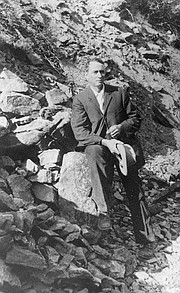Moving History Forward: Ed Pulaski
DICK SHELDON/Special to The Press | Coeur d'Alene Press | UPDATED 4 years, 2 months AGO
Ed Pulaski’s name will forever be a part of Idaho’s rich history, not only because of who he was, but also because of the tool he invented that bears his name. Wherever wildfires are fought, one of the most useful tools in the fight is the Pulaski, a stout, long-handled device whose business end sports an ax attached back-to-back to a hoe. No need to waste time laying down a hoe when you needed an ax! Just rotate your wrist, and there it is. Thus, his name is spoken many times a day by thousands of firefighters at thousands of wildfires worldwide (e.g., “I’m glad I had a Pulaski.”).
Pulaski was born in 1866 in Ohio. Moving west at age 15, he worked in mining and lumbering jobs before settling in Wallace in 1908, where he joined the U.S. Forest Service. At the time of the great fire of 1910, he was the foreman of a large crew of firefighters.
The weather conditions in the summer of 1910 were similar to the conditions we are experiencing here in North Idaho. There had been no rain for months, resulting in extreme dryness. Extremely high temperatures and lightning strikes caused hundreds if not thousands of small fires from Washington to Montana, with Idaho in the middle. Over a few days in late August the fires seemed to coalesce into one enormous megafire, known as the “Big Blow-Up.”
On Aug. 20, Pulaski and a crew were up Placer Creek outside Wallace when the flames became so intense they were forced to flee. Rounding up 45 men, Pulaski ordered them to run for a nearby abandoned mine tunnel. One crew member died on the way, but 44 men arrived to find a small opening with a short tunnel into the hillside.
As the fire roared by, Pulaski ordered the men into the tunnel and to lie face-down, since there would be more oxygen lower and it would be cooler. Some water had puddled in the back of the shaft, and the night was spent pouring available water on everyone and on the timbers maintaining the tunnel. At one point Pulaski passed out, having been overcome by the smoke.
One undocumented story was that a group of men decided to make a run for it, but were ordered to stay put by a determined Pulaski, revolver in hand.
The next morning, 39 men had survived. Although his hands were burned, and his vision and lungs severely damaged by that night in the tunnel, Pulaski continued to work for the Forest Service until 1929. He died in 1931 and is buried in Forest Cemetery in Coeur d’Alene.
Restoration of the long-abandoned site was started in 2002 by Wallace citizens. The Forest Service finished the project in 2005. Now there is a beautiful 4-mile roundtrip trail from the parking area to the mine, with frequent interpretive signs telling the story in detail.
The Museum of North Idaho was planning a Gala for Oct. 16 but has canceled it due to the “vile virus.” We are looking at dates in February 2022. For information about becoming a member of the museum, see www.museumni.org or call 208-664-3448. The museum is open until the end of October, from 11 a.m. to 5 p.m. Tuesday through Saturday.



